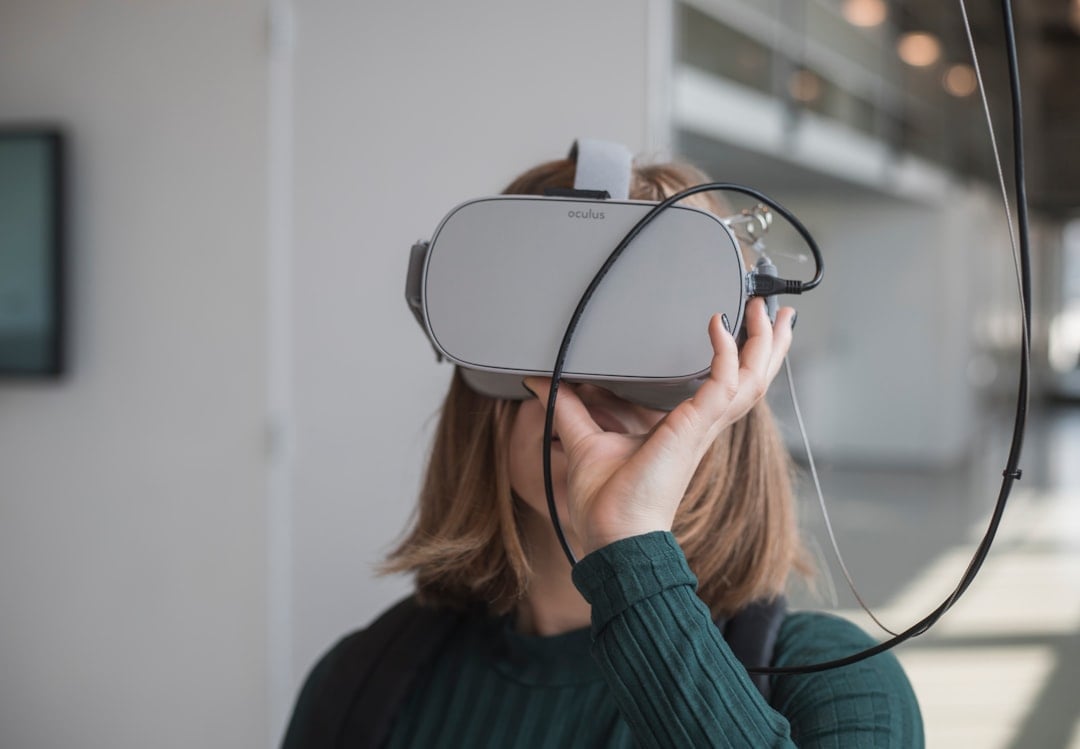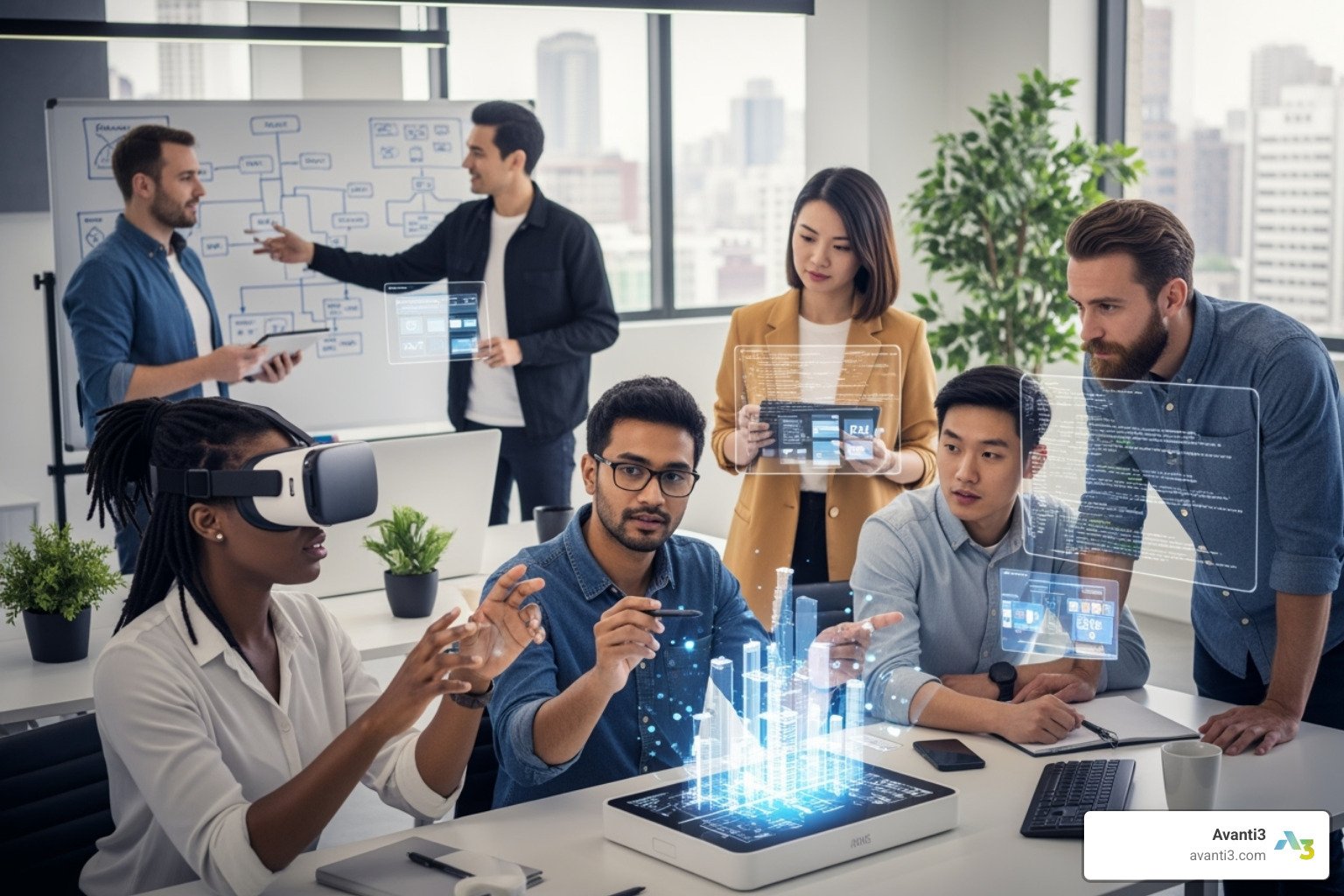VR Content Creation Tools: 10 Powerful Best Picks 2025
The Ultimate Guide to VR Content Creation Tools
VR content creation tools are software platforms that enable developers, designers, and creators to build immersive virtual reality experiences. Here’s a quick overview of the top tools available in 2024:
- Unity – Industry-standard game engine with robust VR development capabilities
- Unreal Engine – Powerful 3D creation platform with photorealistic rendering
- Adobe Aero – AR/VR authoring tool with intuitive interface for beginners
- Tvori – VR animation tool that reduces animation time by up to 80%
- Quill – VR illustration and animation tool for immersive storytelling
- CoSpaces – Educational VR creation platform with block-based coding
- Flipside – Collaborative VR content creation with up to 9 remote users
- Meshy AI – Generates 3D assets from text prompts in under a minute
The global VR market is projected to reach $87 billion by 2030, with content creation tools playing a pivotal role in this growth. As more creators, educators, and businesses accept virtual reality, the demand for accessible and powerful VR authoring tools continues to surge.
The landscape of VR content creation tools has evolved dramatically in recent years, moving from complex programming environments to intuitive platforms that anyone can use. Tools like Tvori have reported up to an 80% reduction in animation time compared to traditional CG methods, while AI-powered solutions like Meshy can generate usable 3D assets in seconds from simple text prompts.
I’m Samir ElKamouny AV, an entrepreneur and marketing expert who has helped businesses implement immersive VR content creation tools to transform their digital engagement strategies. My experience spans from simple 360° video production to complex interactive VR environments that drive measurable business results.
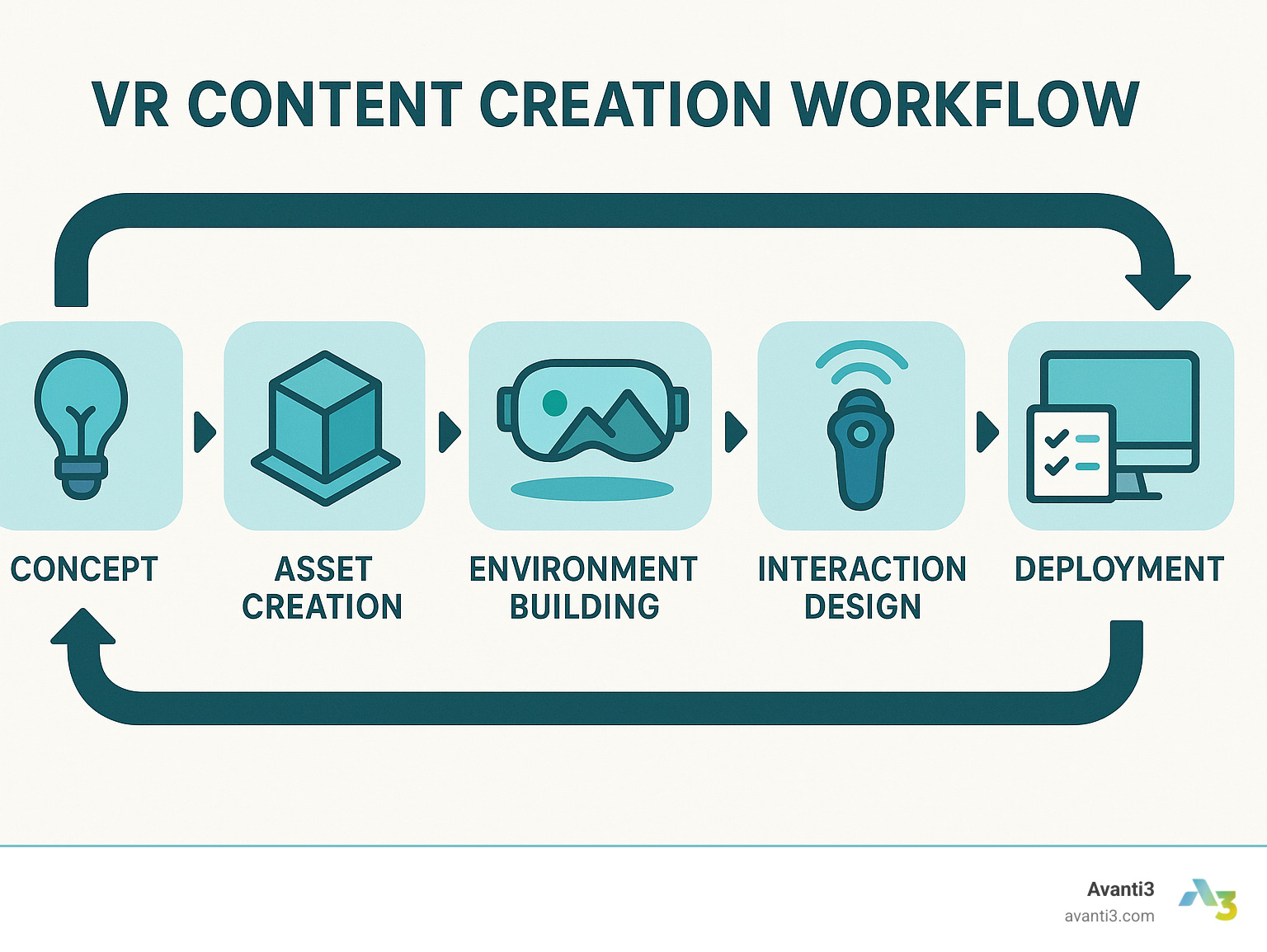
Key VR content creation tools vocabulary:
– blockchain creator economy
– blockchain for artists
– NFT marketplace platforms
What Is VR Content & Why It Matters
VR content encompasses a wide variety of immersive experiences that transport users to virtual environments. These can range from simple 360-degree videos to complex interactive worlds. The primary types include:
- 360° Video: Spherical video recordings that allow viewers to look in any direction from a fixed point
- 3D Virtual Worlds: Computer-generated environments that users can explore and interact with
- Interactive Training Simulations: Realistic scenarios designed for skill development and practice
- Metaverse Events: Social gatherings and experiences in persistent virtual spaces
Why does this matter? VR content delivers unparalleled immersion and presence, making it an incredibly powerful medium for education, training, entertainment, and marketing. Research shows that information retention rates can increase by up to 75% when using VR compared to traditional learning methods. For businesses, VR experiences create memorable brand interactions that drive engagement and conversion.
At Avanti3, we’ve seen how well-crafted VR content can transform customer experiences and open new revenue streams through NFT integration and blockchain-powered engagement.
Mapping the VR Content Landscape
The world of VR content is like a vast digital frontier – diverse, exciting, and constantly evolving. Understanding this landscape is crucial before diving into the VR content creation tools that will bring your vision to life.
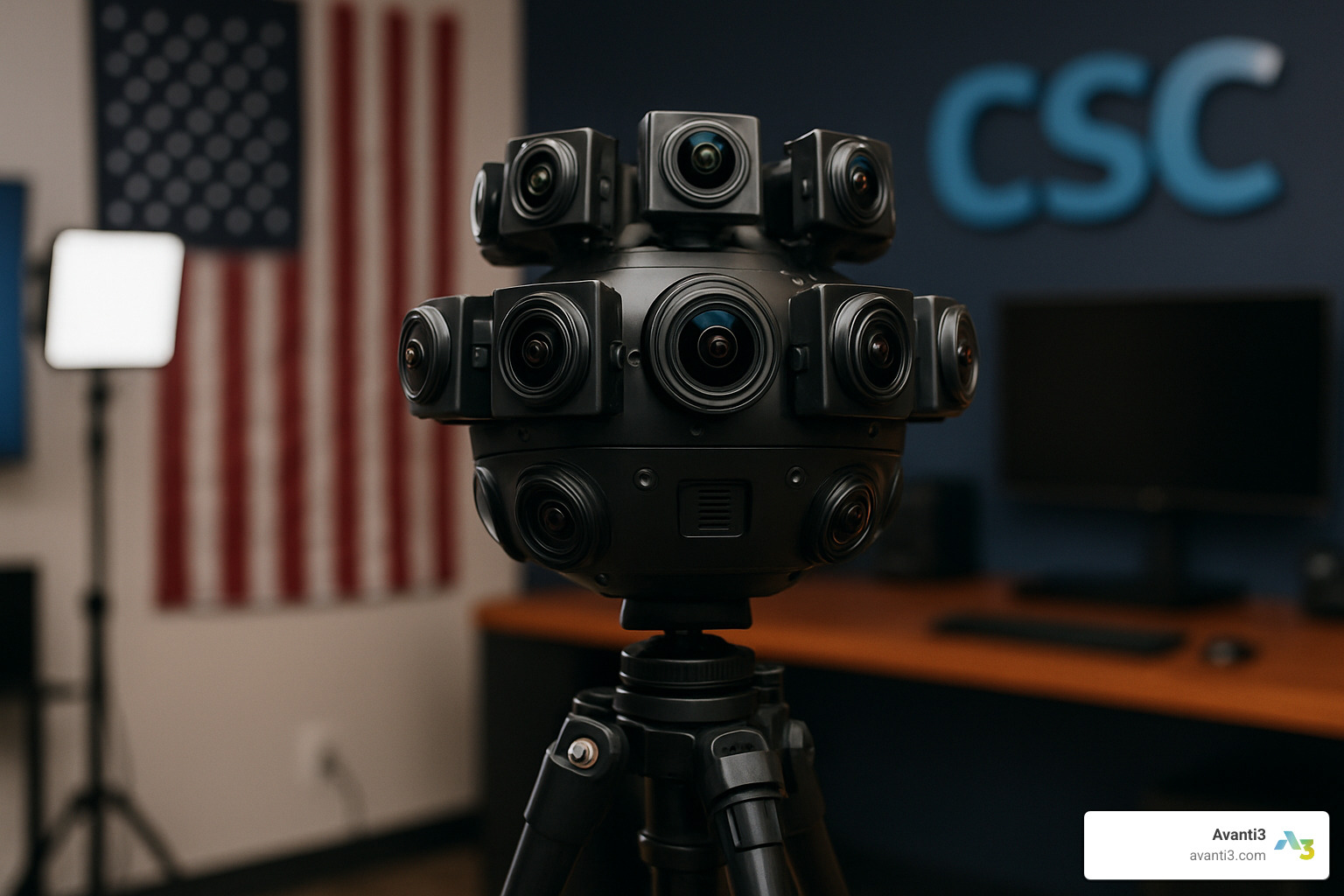
When we talk about VR content, we’re really discussing several distinct categories that each offer unique experiences. 360° Video & Photography transports viewers into immersive scenes where they can look in any direction from a fixed point – perfect for virtual tours and event coverage. Meanwhile, Real-time 3D Environments take immersion a step further, allowing users to freely explore computer-generated worlds, making them the foundation of VR games and architectural visualizations.
For training and education, Interactive Simulations shine with their responsive elements, decision points, and feedback systems. The emerging technology of Volumetric Capture is creating remarkably lifelike 3D recordings of real people and objects, viewable from any angle. And for those seeking the ultimate immersive experience, Haptic Experiences incorporate touch feedback through specialized controllers, adding a physical dimension to virtual worlds.
Main Categories of Tools
The toolbox for creating these experiences is just as diverse as the content itself. VR content creation tools generally fall into six key categories, each serving a specific function in bringing virtual worlds to life.
3D Modeling & Design Tools like Blender, Maya, and ZBrush form the foundation, allowing creators to build the objects and environments that populate VR experiences. Once those assets exist, Animation & Motion Tools such as Tvori and Quill breathe life into them through movement and interaction.
The beating heart of most VR projects is found in Game Engines & Development Platforms – comprehensive environments like Unity and Unreal Engine that tie everything together into interactive experiences. For those without coding expertise, No-Code & Low-Code Authoring Tools like CoSpaces and InstaVR offer accessible entry points to VR creation.
The final pieces of the puzzle include Analytics & User Testing Tools to measure engagement and optimize experiences, and Version Control & Asset Management systems to keep complex projects organized and on track.
| Feature | 3DOF (Degrees of Freedom) | 6DOF (Degrees of Freedom) |
|---|---|---|
| Movement | Rotation only (head turning) | Full movement (rotation + position) |
| Hardware | Mobile VR, standalone headsets | High-end headsets, room-scale VR |
| Content Types | 360° video, basic interactions | Full 3D environments, physical interactions |
| Creation Complexity | Lower – simpler tools | Higher – more sophisticated tools |
| User Immersion | Moderate | High |
| Development Cost | Lower | Higher |
Understanding whether you’re creating for 3DOF or 6DOF experiences is crucial when selecting the right VR content creation tools – this choice impacts everything from complexity to cost.
Typical Workflow From Concept to Deployment
Creating VR content isn’t just about having the right tools – it’s about following a thoughtful process that ensures quality and efficiency. The journey typically begins with Ideation & Concept Development, where you define objectives, audience, and core experience elements through storyboards and user journey maps.
Next comes Storyboarding & Experience Design, planning the narrative flow and spatial layout of your virtual world. With a clear vision established, the Asset Building & Creation phase brings your 3D models, environments, and sounds to life through a blend of custom creation and library resources.
The magic happens during Integration & Programming, where separate elements come together in a game engine or VR platform, gaining interactivity and user interface elements. Before launch, thorough Testing & Optimization ensures technical performance, usability, and comfort for users. Finally, Publishing & Distribution delivers your creation to its intended audience through app stores or custom channels.
At Avanti3, we improve this traditional workflow by weaving in blockchain technology and NFTs, creating unique digital ownership opportunities within VR experiences. This approach not only deepens user engagement but also opens new revenue streams for creators in the virtual field.
More info about Digital Experience Design
VR Content Creation Tools: 2024 Power List
The world of VR content creation tools has exploded with innovation in 2024, making immersive development more accessible and powerful than ever before. Whether you’re a seasoned developer or just starting your VR journey, today’s tools offer something for everyone.
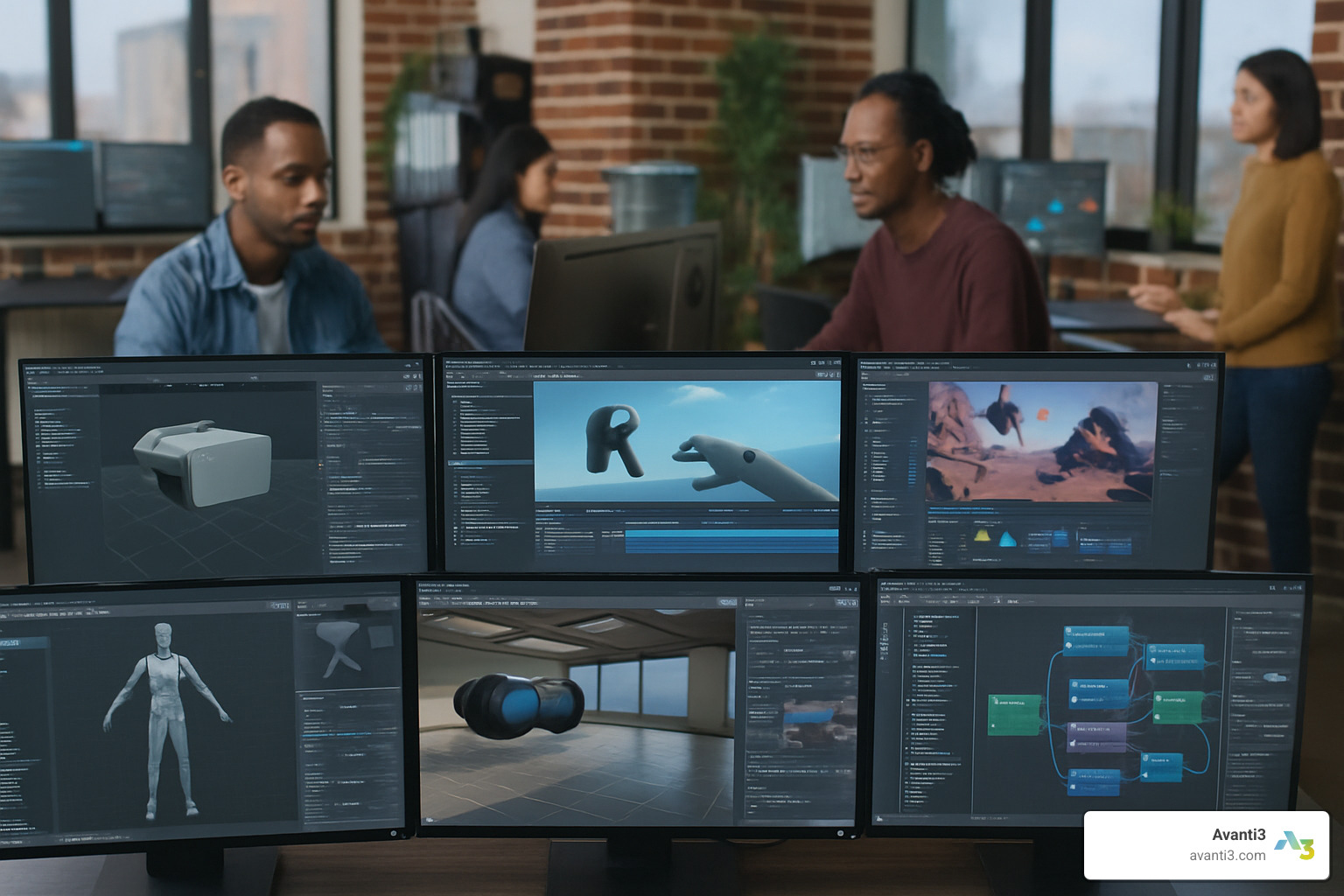
Let’s explore the most impactful platforms changing how we create virtual worlds in 2024.
Leading cross-platform development environments continue to reign as the go-to solution for VR experiences. What makes them special isn’t just their extensive libraries and asset stores, but how they bridge the gap between professional developers and creative non-programmers through visual scripting options.
Meanwhile, advanced game engines have been turning heads with their breathtaking visual capabilities. Thanks to technologies like advanced micropolygon rendering and dynamic global illumination, creators can now build photorealistic VR environments that were previously impossible. Visual scripting systems mean you can prototype complex interactions without writing a single line of code.
For those watching their budget, open-source 3D creation suites deserve special attention. These free tools have evolved into powerhouses for VR asset creation. From modeling and rigging to animation and rendering, they put professional-grade tools in everyone’s hands without the professional-grade price tag.
When it comes to immersive design, VR-native animation tools stand out by letting creators work directly within virtual reality. Many users report slashing their animation time by up to 80% compared to traditional methods – a game-changer for teams with tight deadlines.
Artists with a more expressive style gravitate toward stylized content creation platforms, which excel at creating content that feels handcrafted. Imagine painting in watercolor or oils, but in three dimensions and without the mess!
Collaboration has become central to VR development, and modern design tools shine in this area. By bridging 2D design with immersive 3D experiences, teams can work together seamlessly whether they’re in VR headsets or on standard computers.
For teams that need to work remotely, collaborative VR platforms support multiple users in a shared virtual space. Native integration with avatar customization services adds a personal touch to creative sessions.
Content management challenges haven’t been forgotten either. Modern version control solutions tackle the unique challenges of managing large binary files in VR development. Many offer free tiers for small teams, making enterprise-grade asset management accessible to indie creators.
In educational settings, VR content management platforms serve as central hubs for managing and distributing VR content. Teachers can upload custom experiences in seconds and organize them into playlists for seamless classroom integration.
Most professionals mix and match these tools based on project needs. At Avanti3, we’ve found that combining specialized tools creates workflows that are greater than the sum of their parts, especially when improved with our blockchain and NFT capabilities.
Best No-Code & Low-Code VR Content Creation Tools
Not everyone has the time or inclination to become a coding expert, and that’s perfectly okay! The rise of no-code and low-code VR content creation tools has thrown the doors wide open, welcoming creators from all backgrounds into the virtual reality space.
Node-based authoring tools bring visual programming directly into development environments, letting you create sophisticated VR experiences without writing code. Users report development speeds up to 10 times faster than traditional methods – perfect for rapid prototyping or creators with limited technical resources.
For educators and students, educational VR platforms have become beloved tools that grow with the user. Starting with simple drag-and-drop creation, users can gradually progress to block-based coding and eventually JavaScript as their skills develop.
When speed matters, web-based VR creation platforms shine with their approach to creating and publishing VR experiences from 360° media. Need to prototype a VR lesson in under two hours? These tools make it possible, with export options for all major headsets.
Browser-based creation environments offer interfaces that feel familiar to many designers. Their co-editing features make them particularly valuable for collaborative projects or as a stepping stone to more advanced development environments.
For those who prefer downloadable software, drag-and-drop VR authoring tools provide logic sequences that make interactive VR and AR experiences accessible to non-programmers.
At Avanti3, we’ve found these no-code solutions invaluable for quickly testing concepts before enhancing them with our blockchain technology. This approach lets us rapidly iterate on ideas while still delivering the unique digital ownership opportunities that set our experiences apart.
Best Classroom-Friendly Tools for Educators & Students
The classroom presents unique challenges for VR content creation tools, from limited technical resources to varying student skill levels. Fortunately, several platforms have stepped up to meet these educational needs.
Educational VR platforms strike a perfect balance between accessibility and depth that grows with students. Beginners can start with simple drag-and-drop creation, then progress to block-based coding and eventually JavaScript as their confidence builds. Teachers particularly value the classroom management features and how easily these platforms align with existing curriculum goals.
VR content management systems go beyond content management to provide actual creation tools. Their seamless integration with everyday software makes them versatile enough for art, science, history, and virtually any other subject area.
For creating virtual field trips with minimal technical overhead, interactive 360° content platforms excel at turning ordinary 360° images and videos into interactive learning experiences through annotated hotspots. Students can explore historical sites, ecosystems, or complex machinery with contextual information appearing right where they need it.
Budget-conscious schools appreciate basic 3D modeling tools that come pre-installed on computers. While simple, they allow students to create basic 3D models that can be exported in standard formats for VR viewing – no additional software budget required.
For more advanced modeling, especially in architecture and design courses, educational 3D design software offers free education licenses with a relatively gentle learning curve. Students can design buildings, environments, and objects that transition smoothly into virtual reality for exploration and presentation.
We’ve seen remarkable results when schools introduce these tools progressively throughout a curriculum. Students often show deeper engagement with subject matter when they become creators rather than just consumers of VR content.
At Avanti3, we’re passionate about the transformative potential of immersive education. Our custom solutions can integrate with these classroom-friendly tools to create unique learning experiences improved by blockchain verification and digital ownership concepts – preparing students not just for today’s technology but tomorrow’s as well.
More info about Virtual Reality Experiences
Generative AI & Asset Automation
The world of VR content creation tools has been revolutionized by generative AI, making the once-tedious process of asset creation faster and more accessible than ever before. These smart technologies are truly game-changers, dramatically cutting down the time and expertise needed to create stunning 3D assets for virtual reality.
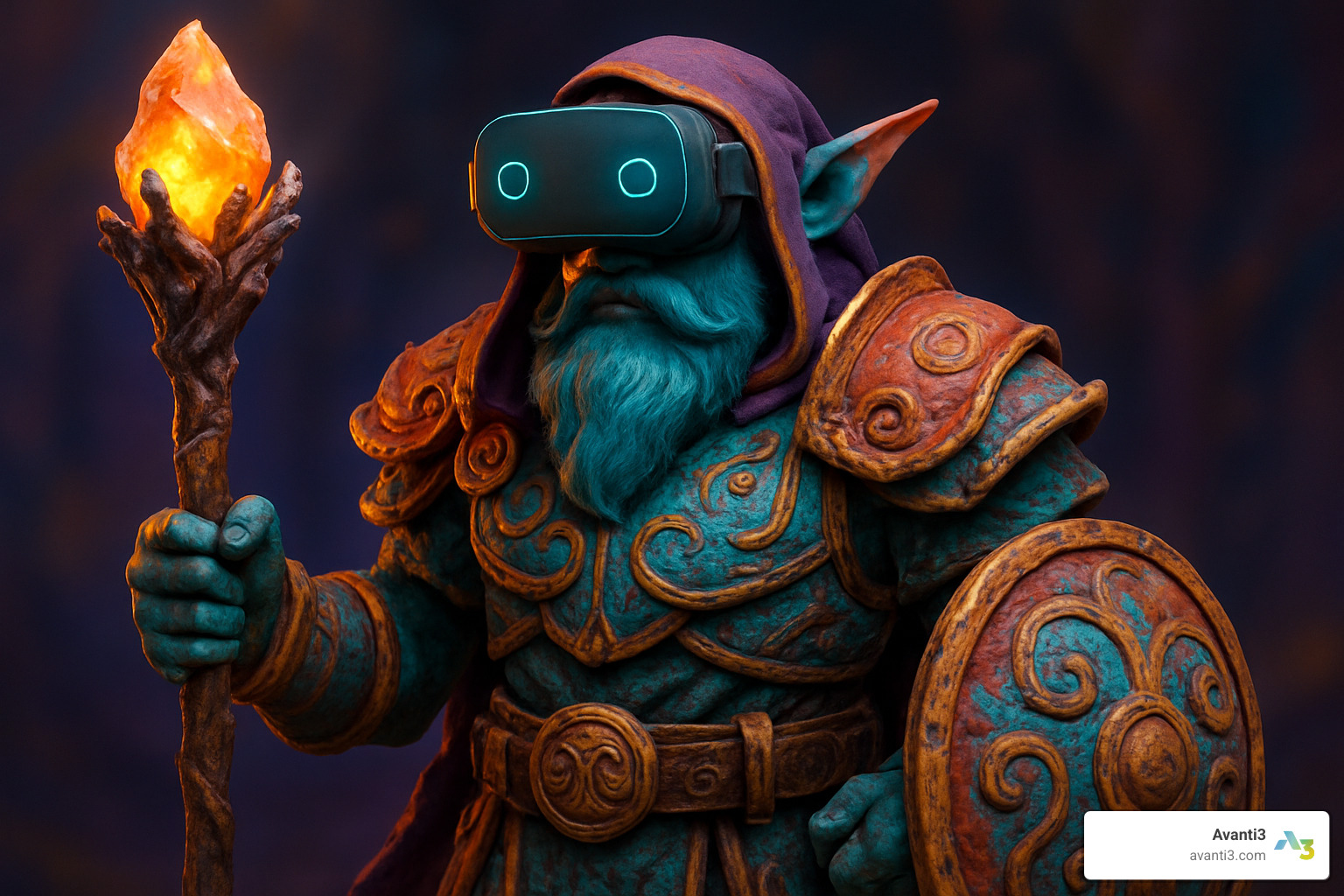
Remember when creating a simple 3D object could take hours? Those days are quickly fading into memory. Today’s AI-powered tools are changing several key aspects of VR creation:
Text-to-3D Model Generation has become almost magical. Advanced AI platforms can conjure fully textured 3D models from simple text descriptions in under a minute. Imagine typing “weathered stone lighthouse on a rocky cliff” and watching as it materializes before your eyes! This capability is incredibly valuable when you’re brainstorming ideas or need to quickly prototype concepts.
Image-to-3D Conversion tools are equally impressive. They can transform ordinary 2D images into detailed 3D models with accurate depth information. This makes digitizing real-world objects as simple as taking a photo and letting the AI do the heavy lifting.
For creating immersive backgrounds, 360° Environment Creation tools excel at generating breathtaking panoramic scenes from text prompts. Even better, these can be converted into full 3D meshes that you can explore in VR. Type “underwater coral reef with sunbeams” and suddenly you’re swimming with the fishes!
Even the painstaking work of Texture Generation and Improvement has been simplified. AI tools can now create high-quality textures from descriptions or improve existing textures to boost visual quality without requiring manual artistic work.
When working with these AI tools, we’ve found a few helpful tips:
– Use solid-color backgrounds when providing images to AI tools
– Adjust lighting settings according to each tool’s recommendations
– Download your assets in .glb format for the best compatibility across VR platforms
What’s particularly exciting is how these AI tools are blending with traditional workflows. It’s not about replacing human creativity but enhancing it—giving creators more time to focus on the experience rather than getting bogged down in technical details. This hybrid approach is especially valuable for smaller teams and independent developers who may not have dedicated 3D artists on staff.
At Avanti3, we’re seeing how these tools are democratizing VR creation, allowing more diverse voices to build immersive experiences without massive technical barriers.
Scientific research on AI-driven 3D generation
Creating Characters & Avatars in Seconds
Remember when creating a single character for your VR project might take days or even weeks? Those days are rapidly disappearing thanks to AI-powered VR content creation tools that can generate ready-to-use avatars and characters while you sip your morning coffee.
Character creation has traditionally been one of the most time-consuming and technically demanding aspects of VR development. It required specialized skills in modeling, rigging, and animation that took years to master. Today’s AI tools are changing all that, making character creation accessible to almost anyone with a creative vision.
Modern avatar platforms offer a delightfully simple approach—upload a selfie, and within moments, you have a customizable avatar that resembles you. While not strictly an AI tool, this efficiency is remarkable, and the resulting avatars can be exported to numerous VR platforms and games. I’ve seen teams create personalized avatars for their entire staff in less than an hour!
For photorealistic human models, AI-powered character creators work like digital sculptors with superhuman speed. Simply describe what you want—”elderly man with glasses and a tweed jacket”—or upload a reference image, and they create remarkably lifelike models complete with clothing and accessories.
AI avatar generation tools bring versatility to the table. They excel at generating characters in various artistic styles—from cartoonish to hyperrealistic. The ability to specify body types and styles means you can create diverse character sets that represent your audience authentically.
Professional developers often turn to advanced character creation software with AI plugins. These tools now incorporate AI that can generate diverse human characters or transform 2D concept art into fully-realized 3D character models with impressive accuracy.
The typical workflow is refreshingly straightforward:
1. Provide a description or reference image
2. Watch as the AI generates your base character model
3. Tweak and customize details to match your vision
4. Export in a VR-compatible format (.glb or .fbx)
5. Import into your VR development environment and bring it to life
At Avanti3, we’re particularly excited about connecting these AI-generated avatars with blockchain technology. Imagine creating unique, verifiably-owned digital identities that users can take with them across different virtual experiences. This blend of AI, VR, and blockchain opens fascinating possibilities for digital identity and ownership that simply weren’t possible before.
The barrier to entry for creating compelling VR characters has never been lower, and the creative possibilities have never been more exciting.
Choosing the Right Tool & Collaborating at Scale
Selecting the perfect VR content creation tools for your project isn’t just about picking the shiniest new technology—it’s about finding the right fit for your team, project, and vision. Think of it like choosing the right ingredients for a recipe—the best choices depend on what you’re cooking and who’s doing the cooking!
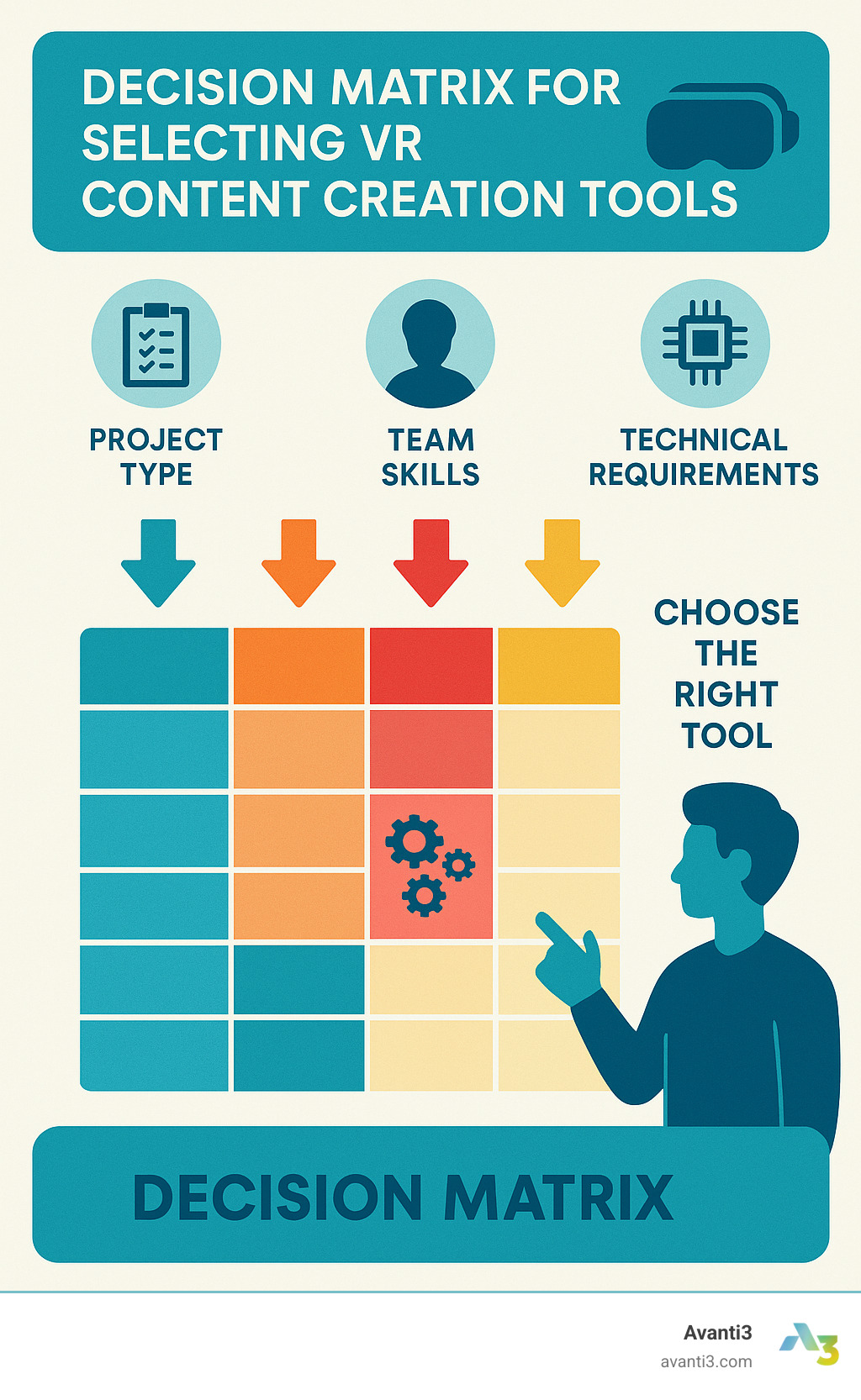
When we work with clients at Avanti3, we always start by understanding the human factors. Does your team have coding wizards or creative minds who’d rather avoid technical complexity? Usability and learning curve matter tremendously here. If you’re working with a team of non-technical creators, no-code platforms like InstaVR or CoSpaces might be your best friends. They offer intuitive interfaces that let you focus on creativity rather than code. For teams with technical expertise, Unity or Unreal Engine open up worlds of possibility—though they’ll require more training time.
Compatibility is another crucial consideration. Nothing’s more frustrating than creating a stunning VR experience only to find it won’t run on your target hardware! Before committing to any tool, verify it supports the headsets your audience will use. Some platforms work beautifully with Quest headsets but struggle with others, or vice versa.
Think about the future, too. Will your modest project evolve into something grander? Scalability matters when your VR ambitions grow. Choose tools that can accommodate increasing complexity without forcing you to start over. We’ve seen too many projects hit painful roadblocks when their initial tools couldn’t handle expanding asset libraries or more complex interactions.
Connection is key in our digital ecosystem. The best VR content creation tools don’t exist in isolation—they play well with others. Consider how your VR experiences will integrate with your existing digital infrastructure, whether that’s a learning management system for educational content, e-commerce platforms for virtual shopping experiences, or analytics tools to measure engagement.
For teams working together, collaboration features can make or break your workflow. Real-time co-editing in tools like Flipside or Vizor VR transforms VR creation from a solitary pursuit into a shared creative journey. Robust version control through systems like Helix Core ensures nobody’s work gets lost in the shuffle. Look for tools that support smooth asset sharing, intuitive feedback systems, and clear communication channels.
Finally, don’t overlook performance optimization. VR demands smooth, responsive experiences—even small hiccups can break immersion or cause discomfort. Tools with built-in optimization features help ensure your creations run beautifully across different hardware setups.
At Avanti3, we’ve developed hybrid approaches that combine multiple tools to leverage their unique strengths while integrating our blockchain and Web3 capabilities. This allows us to create technically sophisticated experiences that include unique digital ownership opportunities—something increasingly important in today’s evolving digital landscape.
More info about Digital Engagement Solutions
Pricing Models & Open-Source Options
Let’s talk about everyone’s favorite topic—money! The world of VR content creation tools offers everything from completely free options to enterprise solutions that might make your CFO raise an eyebrow.
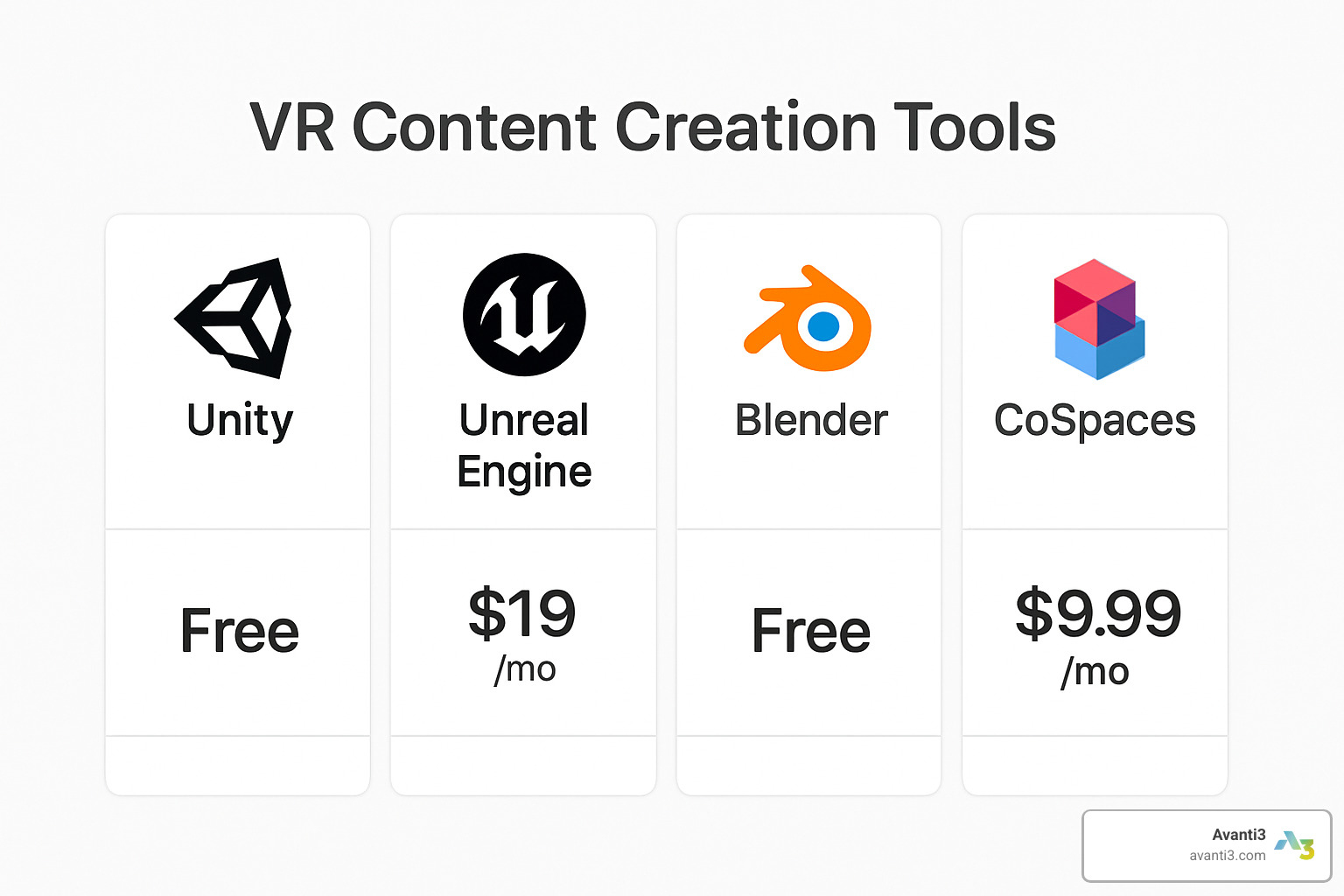
Freemium models have become increasingly popular in the VR tools space. Blender stands out as a remarkable example—a professional-grade 3D creation suite that’s completely free and open-source. Other tools like CoSpaces offer generous free tiers that let you test the waters before diving in with a paid subscription. ClassVR Portal takes a different approach, providing free software when you purchase their hardware—similar to how gaming consoles operate.
Subscription-based pricing dominates much of the VR creation landscape today. Monthly or annual payments give you access to regularly updated tools and features. Build-VR starts at a reasonable $29 per user monthly (when billed annually), making it accessible for smaller teams. InstaVR aims at more professional use cases with pricing from $199 per user monthly. At the enterprise level, tools like Forge begin around $400 monthly with annual billing. These subscription models often scale based on features or the number of users, allowing you to start small and grow as needed.
While less common nowadays, some specialized VR tools still offer one-time purchase options. This approach can be cost-effective for stable, long-term projects where you don’t necessarily need the latest features.
For projects with variable demands, pay-as-you-go pricing provides flexibility. This model is particularly common with cloud-based rendering services and AI asset generation tools where usage can fluctuate dramatically from month to month.
Don’t overlook the power of open-source options. Beyond Blender, the VR creation ecosystem offers several impressive free tools. A-Frame provides a web framework for building browser-based VR experiences using familiar HTML—perfect for web developers dipping their toes into VR waters. Godot Engine is gaining traction as an open-source alternative to commercial game engines, with improving VR support. OpenXR isn’t a creation tool itself but an open standard ensuring compatibility across VR hardware and software—something worth considering in your technology stack. Even Helix Core, a professional-grade version control system designed for game and VR development, offers a free tier for small teams (up to five users and twenty workspaces).
At Avanti3, we believe in making immersive technology accessible to creators of all budget levels. We often help clients leverage open-source tools as part of a cost-effective approach, while providing premium value through our blockchain integration and Web3 capabilities. Sometimes the most powerful solution combines free and paid tools in creative ways!
Performance & Best Practices
Creating memorable VR experiences isn’t just about visual wow-factor—it’s about crafting worlds that run smoothly and feel comfortable to explore. Let’s explore some hard-earned wisdom about making VR content that performs beautifully.
First, let’s talk polygons—those tiny geometric faces that make up 3D models. Managing polycount is like budgeting your money; spend wisely on what matters most. Different VR platforms have different tolerance levels: mobile VR headsets struggle beyond 100,000 polygons per scene, while PC-based VR can handle 1-2 million, and high-end systems push beyond 3 million. The secret is allocating your polygon budget to elements that truly matter to your experience.
Texture optimization might sound technical, but it’s really about being smart with your visual resources. Combining multiple textures into a single atlas reduces the number of “handshakes” between your software and hardware, improving performance. It’s like packing efficiently for a trip—one well-organized suitcase is better than several scattered bags.
Nothing breaks VR immersion faster than stuttering visuals. Frame rate targets are non-negotiable for comfortable experiences: aim for at least 72 frames per second, with 90fps being the sweet spot for most platforms. Some cutting-edge headsets can reach 120fps, creating incredibly smooth experiences for users.
When creating vast VR worlds, use Level of Detail (LOD) systems—they’re like having different resolution versions of each object that swap automatically based on distance. Why render thousands of polygons for a tree in the distance when a simpler version looks identical from afar? This smart resource management keeps your world running smoothly.
Beyond technical considerations, user comfort should always be your north star. Avoid rapid camera movements that can trigger motion sickness. Maintain consistent frame rates throughout the experience. Provide stable reference points that help users stay oriented. Your most visually stunning creation means nothing if users feel queasy after two minutes!
Design intuitive interactions that feel natural rather than forcing users to learn complicated control schemes. What seems obvious to you might confuse others, so test with diverse users—different hand sizes, heights, and experience levels. The best VR interactions almost disappear, letting users focus on the experience rather than the interface.
VR should be for everyone. Accessible design means considering users with different abilities by providing options for seated experiences, one-handed controls, and visual/audio alternatives where appropriate. Inclusive design expands your audience and often improves the experience for all users.
For teams working together, establish clear collaborative workflows. Implement robust version control to track changes and prevent conflicts. Create consistent naming conventions for assets so everyone can find what they need. Document your design decisions and technical specifications. Schedule regular team reviews in VR headsets—there’s no substitute for experiencing your creation firsthand!
At Avanti3, we’ve refined these practices through numerous projects and continue to evolve our approach as VR technology advances. Our integration of blockchain technology adds another dimension, particularly around optimizing performance for seamless Web3 interactions. The magic happens when technical excellence meets creative vision—creating experiences that don’t just work, but truly transport users to new worlds.
Frequently Asked Questions About VR Content Creation
How do no-code tools compare with advanced development platforms?
I’ve worked with teams at both ends of the technical spectrum, and this question comes up constantly. The truth is, both no-code VR content creation tools and advanced platforms have their sweet spots.
No-code tools are genuine game-changers for many creators. They’ve democratized VR creation in amazing ways. A marketing team I worked with recently went from zero VR experience to a functional product demo in just two days using a no-code platform – something that would have taken weeks with traditional development.
The magic of these tools is their accessibility. You don’t need a computer science degree to create something impressive. They excel at rapid prototyping (often 10x faster than coding from scratch), and they’re perfect for educational settings where technical skills vary widely.
But they do have limitations. You’ll eventually bump into customization walls, performance constraints, and features you simply can’t implement without deeper access to the underlying code.
Advanced development platforms sit at the opposite end of the spectrum. They offer incredible creative freedom and performance optimization capabilities, but at the cost of a much steeper learning curve. I’ve seen developers spend months mastering these tools – time well spent for commercial projects but potentially overkill for simpler experiences.
Many of our most successful clients at Avanti3 actually use both approaches. They’ll prototype quickly in no-code environments to validate concepts with stakeholders, then move to advanced platforms for final production when the concept is proven. It’s a pragmatic approach that balances speed and capability.
Can I use AI to replace traditional 3D modeling entirely?
This question reminds me of when digital cameras first appeared and people wondered if darkrooms would disappear overnight. The reality turned out to be more nuanced.
Today’s AI-powered VR content creation tools are remarkable but not yet complete replacements for traditional modeling. They’re more like incredibly talented assistants.
AI tools shine at generating initial concepts with stunning speed. I recently watched a designer use an AI generation tool to create twenty different furniture variations in the time it would have taken to manually model just one piece. For background assets, environments, and rapid iterations, these tools are revolutionary.
Where traditional modeling still holds its ground is precision and control. When we need exact specifications for a medical training simulation or perfect mechanical functionality for an interactive machine, human expertise remains essential. The same goes for character rigging, complex animation, and performance optimization.
The most effective creators I know use a thoughtful hybrid approach. They’ll use AI to generate the initial asset or concept, then refine it with traditional 3D modeling tools. This combines the speed of AI with the precision of human craftsmanship.
I expect this balance to shift as AI continues to evolve, but I don’t see human creativity becoming obsolete. The tools change, but the artistic vision and technical judgment remain uniquely human contributions.
What’s the easiest way to share VR content across multiple headsets?
This is one of those questions with no perfect one-size-fits-all answer, but I can share what’s worked best in different scenarios.
For maximum accessibility with minimal technical barriers, WebXR is hard to beat. These web-based VR experiences run in compatible browsers, making them shareable via a simple URL. I’ve seen teachers transform their classrooms by sending a single link that works across various devices. Tools like A-Frame and Three.js make this approach increasingly viable, though they do have limitations for more complex interactions.
When you need more powerful features while maintaining broad compatibility, cross-platform development tools become essential. Modern XR development frameworks have become something of a standard here. While they require more technical knowledge, they allow you to build once and deploy across multiple platforms with relatively minimal adjustments.
For educational settings with multiple headsets, specialized VR content management platforms offer remarkably streamlined solutions. I visited a school that manages 30 headsets through a single dashboard, pushing new content to all devices with just a few clicks.
Enterprise users face similar challenges at scale. Cloud streaming services are gaining traction here, particularly when you need to deliver high-end experiences to lower-powered headsets. The content runs on powerful servers and streams to the devices, ensuring consistent quality regardless of the headset’s processing power.
At Avanti3, we’ve developed custom solutions that integrate blockchain verification into content distribution, allowing users to access their owned VR experiences across multiple devices while maintaining their digital ownership rights. This approach is particularly valuable in the emerging creator economy where digital ownership adds significant value.
For most creators just getting started, I recommend cross-platform development frameworks as the most versatile option, or WebXR for simpler content that needs to reach the widest possible audience.
Conclusion
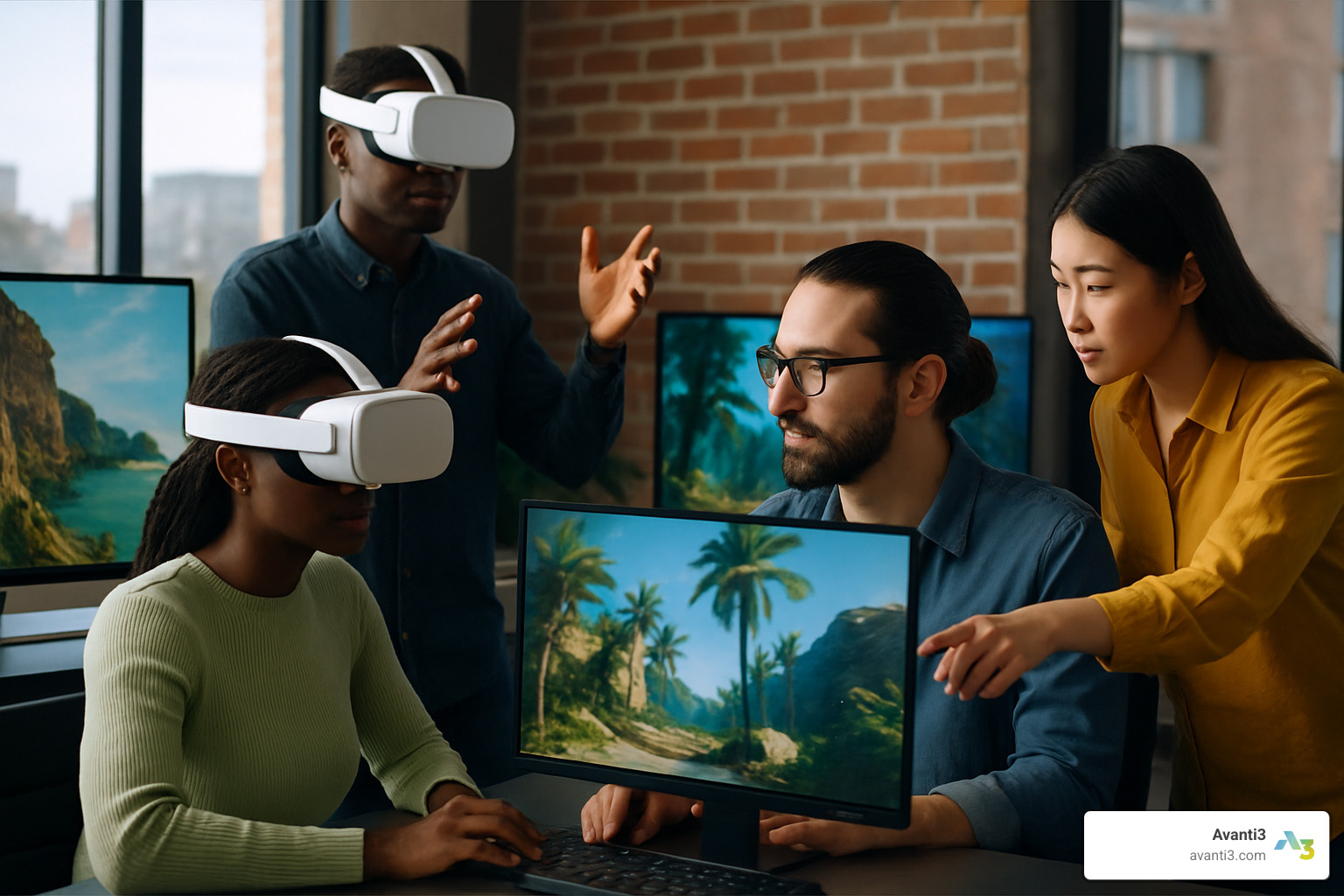
What an exciting time to be exploring VR content creation tools! The landscape has transformed dramatically, making immersive development accessible to nearly everyone with a creative vision. Whether you’re drawn to AI-powered asset generation that can create 3D models in seconds or the intuitive drag-and-drop interfaces of no-code platforms, the gates to virtual reality creation have been flung wide open.
Throughout our journey together, we’ve seen how choosing the right tools can make all the difference. Maybe you’re an educator looking to transport your students to ancient Rome, a business owner visualizing your next product line in 3D, or a storyteller crafting narratives that literally surround your audience. Whatever your vision, there’s a perfect combination of tools waiting to bring it to life.
I’ve been particularly struck by how collaborative the VR creation process has become. Gone are the days when building virtual worlds required isolated developers hunched over complex code. Today’s tools emphasize shared workspaces, real-time feedback, and team-based approaches that make the creative process as engaging as the final experience.
At Avanti3, we’re especially thrilled about blending VR experiences with Web3 technologies. This powerful combination creates something truly magical – immersive worlds where users don’t just visit but can actually own pieces of the experience. By integrating blockchain, NFTs, and decentralized ownership models, creators can forge deeper connections with their communities and find fresh revenue streams that weren’t possible before.
The future isn’t just about building virtual spaces—it’s about creating valuable digital experiences that blur traditional boundaries. As these tools become more intuitive and powerful, your imagination becomes the primary limiting factor rather than technical know-how.
I encourage you to dive in and start experimenting! Begin with a simple 360° video project or sketch out that interactive environment you’ve been dreaming about. The journey into VR content creation might have challenging moments, but the thrill of seeing others step into a world you’ve built makes it all worthwhile. And remember, we at Avanti3 are here to guide you through each step of the process, helping you steer both the creative and technical aspects of building immersive experiences.

